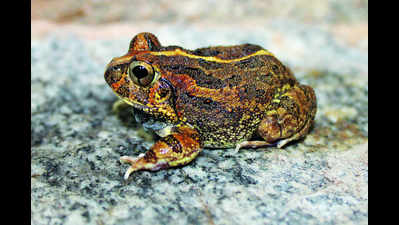- News
- City News
- bengaluru News
- Burrowing frog species named after Bengaluru
Trending
This story is from November 28, 2020
Burrowing frog species named after Bengaluru
A group of researchers from multiple Indian institutions and one from France has found a new species of burrowing frog and named it Sphaerotheca bengaluru, honouring India’s Silicon City.

The new species is described based on the morphological differences and molecular approach with the known species of burrowing frogs (across South Asia, the distribution range)
BENGALURU: A group of researchers from multiple Indian institutions and one from France has found a new species of burrowing frog and named it Sphaerotheca bengaluru, honouring India’s Silicon City. Research findings of the group’s study have been published in the international journal Zootaxa.
Deepak P, assistant professor, Mount Carmel College, KP Dinesh from Zoological Survey of India (ZSI), Pune, Annemarie Ohler from the Institute of Systematic, Evolution, Biodiversity, National Museum of Natural History, France, Prof Kartik Shanker from the Centre for Ecological Sciences (CES), Indian Institute of Science (IISc), BH Channakeshavamurthy from ZSI, Calicut and JS Ashadevi, professor, Yuvaraja’s College, Mysuru, conducted the study.
“Amphibian discoveries in India have been rising in the recent past with most findings concentrated on the biodiversity hotspots of the country or at least forested landscapes with green cover. In one of the efforts of documenting ‘Amphibians in the Deccan Plateau parts of Karnataka’, Deepak encountered the new species of frog and published his findings in a collaborative effort with other institutes’ scientists,” a statement issued here read.
The new species is described based on the morphological differences and molecular approach with the known species of burrowing frogs (across South Asia, the distribution range).
Scientist KP Dinesh said they weren’t biased to any specific biogeographic location or ecosystem, taxonomically. “We’re exploring amphibians throughout India,” he said, adding that they are trying to understand the patterns of discoveries of new species in the country and attempting to unravel new ones from the fastest-growing cities, which are witnessing rapid urbanisation.
The statement further added that the new species has been reported and described from the peri-urban zones of Bengaluru, which are mainly dominated by agroecosystems mixed with dry deciduous vegetation without any permanent water resources (essential for completing the life cycle of amphibians). “However, more detailed field studies are warranted for the species to understand the distribution range and its natural history studies,” the statement added.
Deepak P, assistant professor, Mount Carmel College, KP Dinesh from Zoological Survey of India (ZSI), Pune, Annemarie Ohler from the Institute of Systematic, Evolution, Biodiversity, National Museum of Natural History, France, Prof Kartik Shanker from the Centre for Ecological Sciences (CES), Indian Institute of Science (IISc), BH Channakeshavamurthy from ZSI, Calicut and JS Ashadevi, professor, Yuvaraja’s College, Mysuru, conducted the study.
“Amphibian discoveries in India have been rising in the recent past with most findings concentrated on the biodiversity hotspots of the country or at least forested landscapes with green cover. In one of the efforts of documenting ‘Amphibians in the Deccan Plateau parts of Karnataka’, Deepak encountered the new species of frog and published his findings in a collaborative effort with other institutes’ scientists,” a statement issued here read.
The new species is described based on the morphological differences and molecular approach with the known species of burrowing frogs (across South Asia, the distribution range).
Pointing out how increased urbanisation has resulted in diminishing green cover, making water resources in Bengaluru inhabitable for frogs, the researchers said the new species was named after Bengaluru to highlight the lacunae in documentation of amphibians from non-forested areas and to restore their habitats (freshwater bodies) in the city.
Scientist KP Dinesh said they weren’t biased to any specific biogeographic location or ecosystem, taxonomically. “We’re exploring amphibians throughout India,” he said, adding that they are trying to understand the patterns of discoveries of new species in the country and attempting to unravel new ones from the fastest-growing cities, which are witnessing rapid urbanisation.
The statement further added that the new species has been reported and described from the peri-urban zones of Bengaluru, which are mainly dominated by agroecosystems mixed with dry deciduous vegetation without any permanent water resources (essential for completing the life cycle of amphibians). “However, more detailed field studies are warranted for the species to understand the distribution range and its natural history studies,” the statement added.
End of Article
FOLLOW US ON SOCIAL MEDIA










